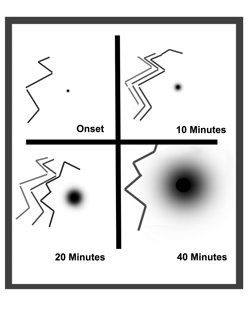|
|
 Previous Chapter Previous Chapter  Previous Page Next Page Previous Page Next Page  Next Chapter Next Chapter 
Identifying Migraine
Headaches and Auras
Identifying women who suffer from migraine headaches and/or auras is important because migraines, and aura in particular, are linked to higher risk of stroke. Some hormonal contraceptives can increase that risk further.
Migraine Headaches
- Recurring, throbbing, severe head pain, often on one side of the head, that can last from 4 to 72 hours.
- Moving about often makes the migraine headache worse.
- Nausea, vomiting, and sensitivity to light or noise may also occur.
Migraine Auras

People describe visual auras as bright, shimmering lines or waves around a bright area of lost vision that increase in size and turn into a crescent shape with zigzag edges. The black spot represents how the area of lost vision increases in size over time.
- Nervous system disruptions that affect sight and sometimes touch and speech.
- Almost all auras include a bright area of lost vision in one eye that increases in size and turns into a crescent shape with zigzag edges.
- About 30% of auras also include a feeling of "pins and needles" in one hand that spreads up the arm and to one side of the face. Some auras also include trouble with speaking. Seeing spots or flashing lights, or having blurred vision, which often occurs during migraine headaches, is not aura.
- Auras develop slowly over several minutes and go away within an hour, typically before the headache starts. (In contrast, a sudden blackout in one eye, particularly with a feeling of "pins and needles" or weakness in the opposite arm or leg, may indicate a stroke.)
 Previous Chapter Previous Chapter  Previous Page Next Page Previous Page Next Page  Next Chapter Next Chapter 
|